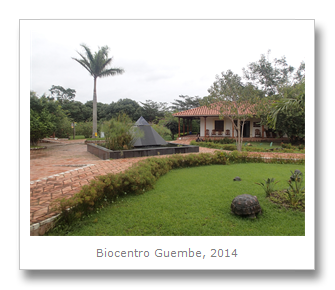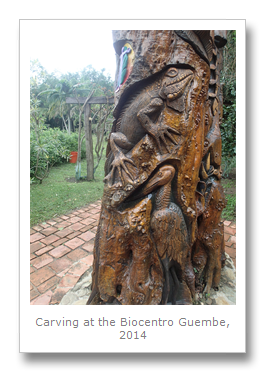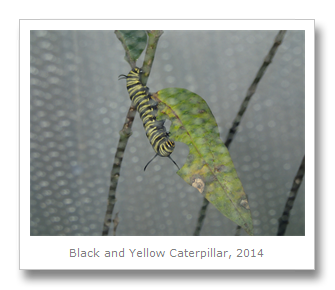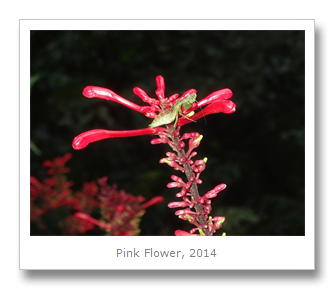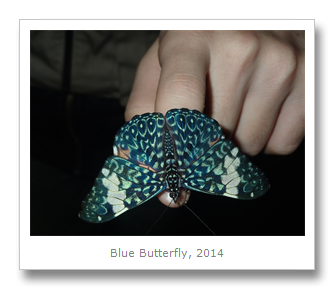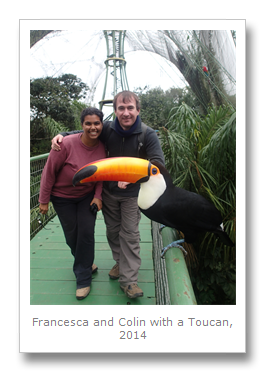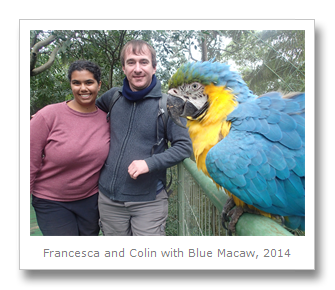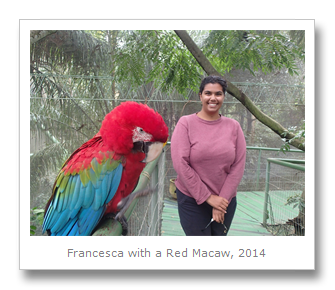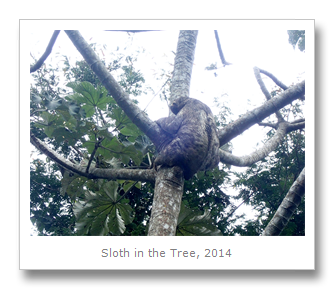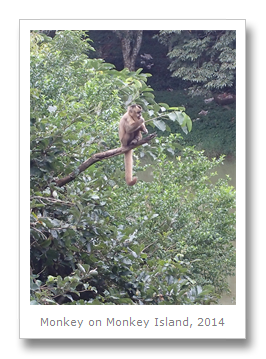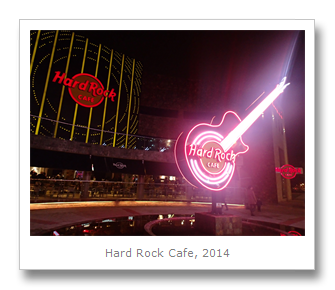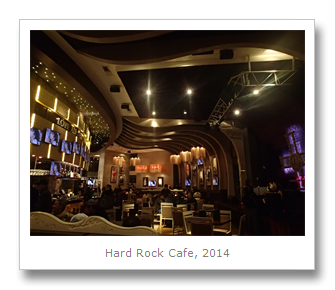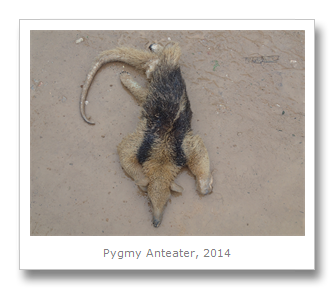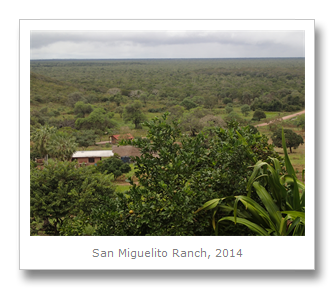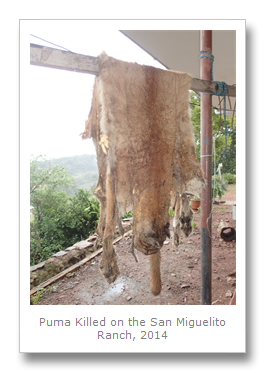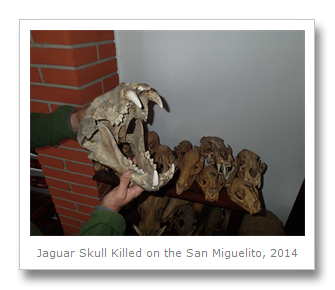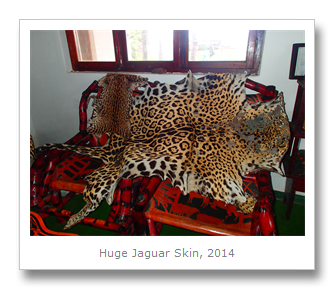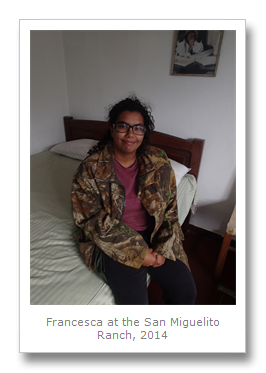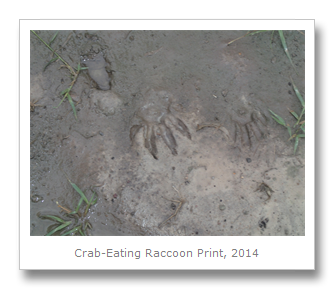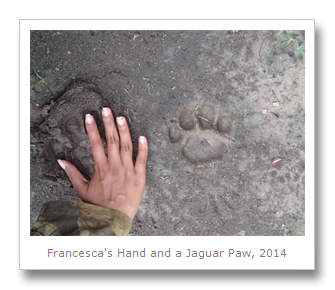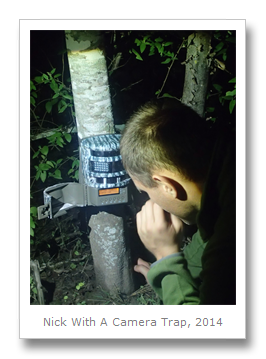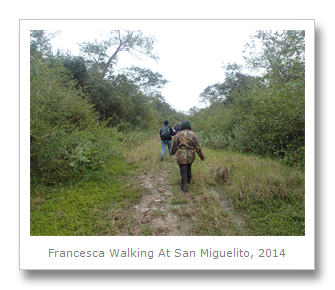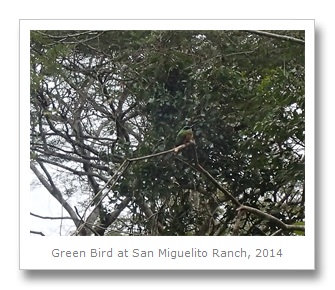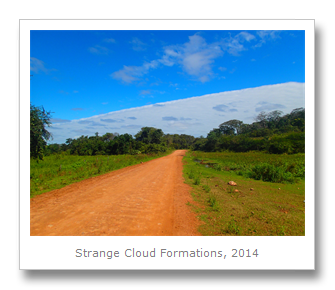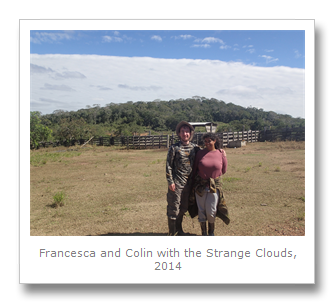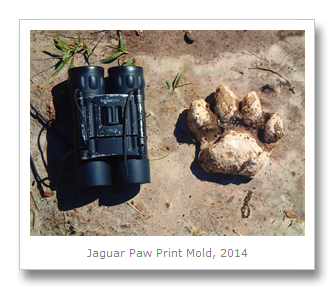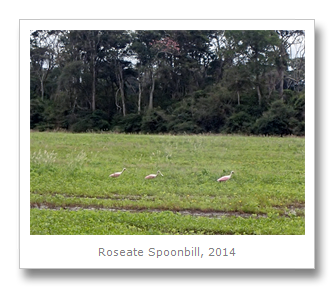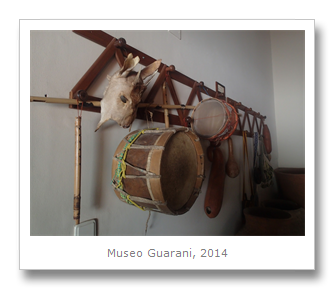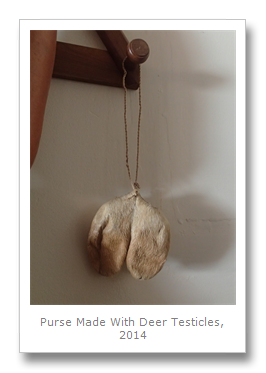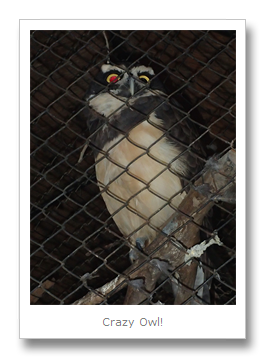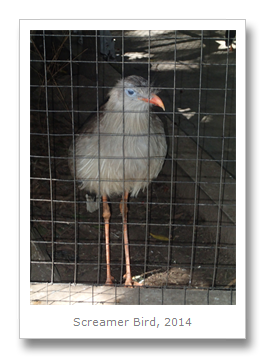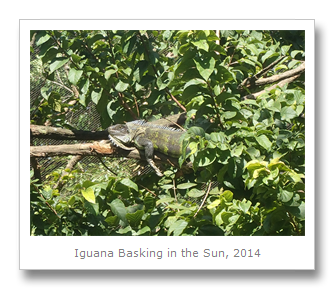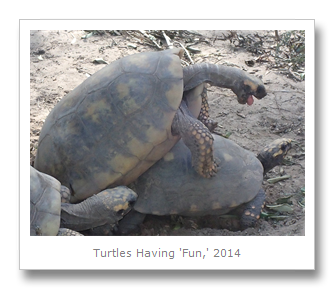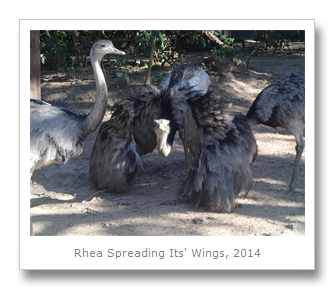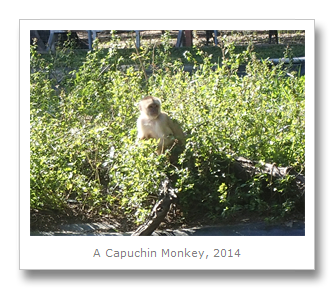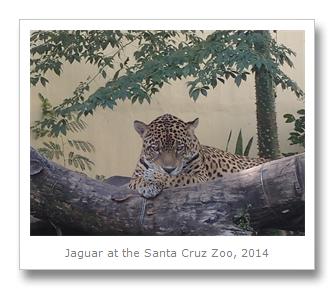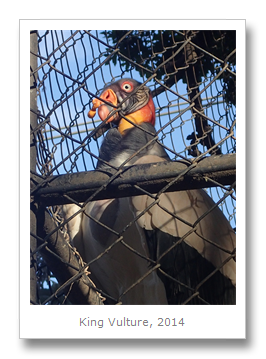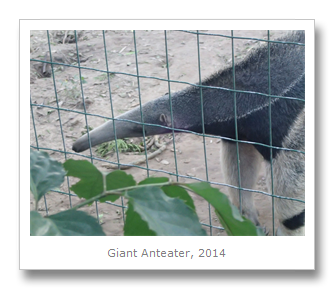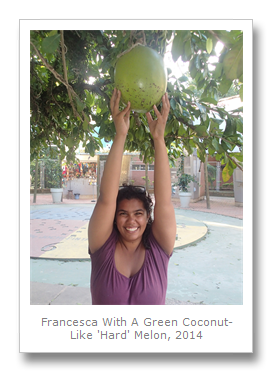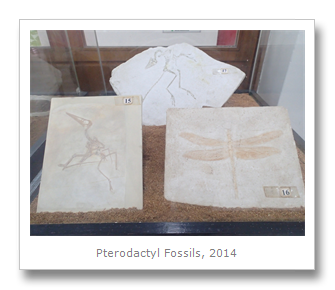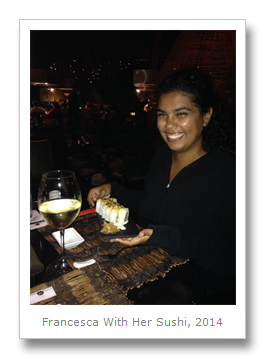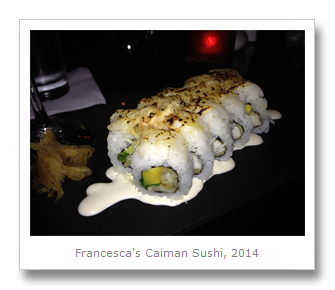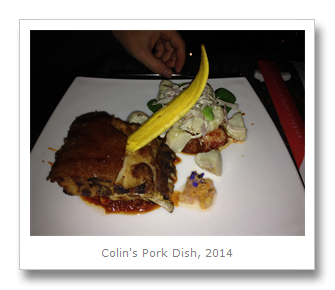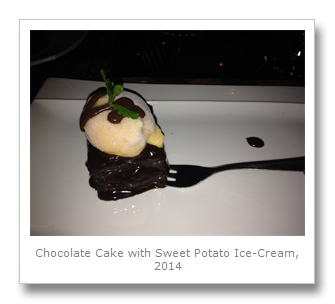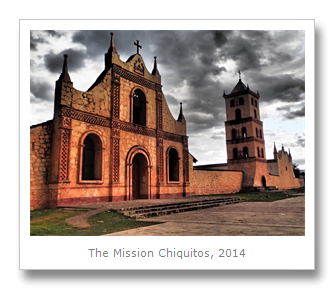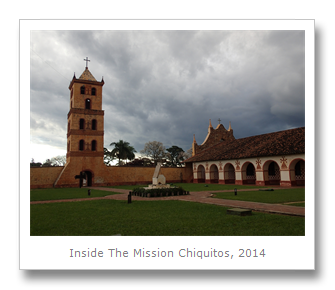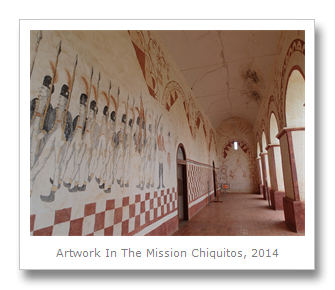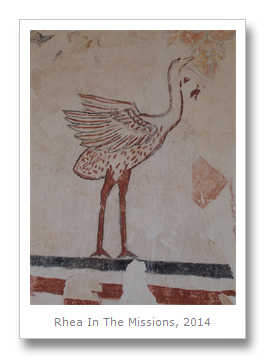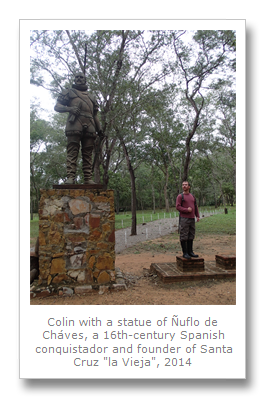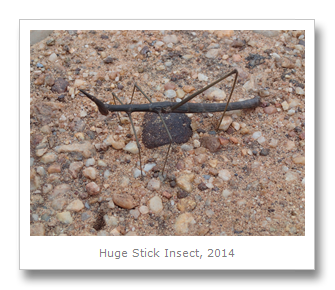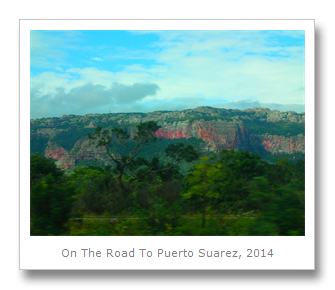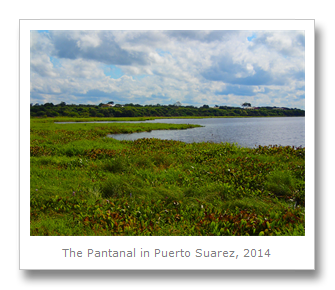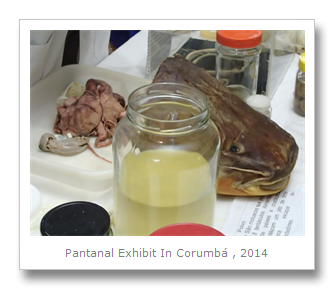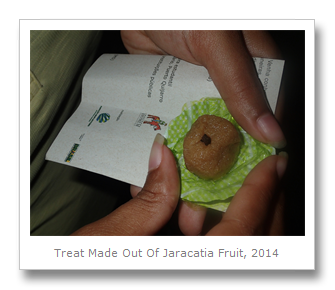On May 23rd we took a flight to Santa Cruz, out in the flooded eastern areas of Bolivia. It wasn’t a long flight, but the views we had of lush green forests while coming into land at Santa Cruz airport were fantastic. One of the first things we did was take a journey out to a hotel/animal sanctuary called Biocentro Guembe. We decided to go on a guided tour of the area and we were led through the butterfly garden, into an awesome 2400 square meter aviary (with macaws, parrots, toucans, etc.) and then past a monkey island where squirrel monkeys, capuchin monkeys, and other monkeys. We even saw another couple of sloths! Colin and I managed to get a lot of fantastic photos of ourselves with the birds!
After our trip to the Biocentro Guembe Colin and I headed to the home of Nick from Nick’s Adventures where we arranged our tour for the following day. Next we went for a great dinner of cheeseburgers and onion rings at Hard Rock Café, where we bought my Uncle Randy another Hard Rock pin!
The next morning Nick from Nick’s Adventures picked us up and brought us out to a cattle ranch called San Miguelito. This trip (unbeknownst to us) was the first trip he had made with tourists out to the ranch. In the 3 days and 2 nights that we were at the ranch we didn’t see many animals, except for one brocket deer and some birds. At the very start of the trip we saw a pygmy anteater as road-kill on the side of the road, and we did drive towards a crab-eating raccoon but Nick’s friend (who was driving the car at the time) was driving WAY too fast for us to see any animals and the raccoon ran off before we could get a good look at it. She continued this kind of insanely fast driving through the entire trip, despite Nick and our group asking her to slow down multiple times… and it was not a good animal-spotting trip at all, for multiple reasons.
Basically the area around Santa Cruz was WAY too flooded and muddy to access many roads, making it extremely difficult to find animals. We spent much of the time getting our boots stuck in the mud, and the only interesting things we did accomplish were making plaster molds of jaguar (and other animals) paw prints and seeing a few beautiful birds. The workers at the ranch killed a puma just one month before we arrived, and killed a jaguar cub only a week after we left – so we don’t have much hope that tourism at the ranches will make any difference to the rate at which the cats are being killed. We learned about how jaguar-hunting trips are extremely common, with many of the big ranches charging $30,000 USD for a trip to ignorant, rich Western hunters. The ranch owner ends up with $10,000 USD which is an insane amount of many for Bolivia. When you have someone willing to pay that much to kill the cats, forget about trying to pay a fraction in an attempt to see them.
The San Miguelito ranch has captured images of 3 separate jaguars and 2 pumas over an area of just 12 square kilometers. This is a good density of big cats, with the Chaco and relatively nearby Pantanal containing a good deal of the jaguars that are left.
We wrote a letter to Nick about his new venture, our disappointments, and our suggestions. I will post this letter here which outlines our thoughts on his San Miguelito Trip:
______________________________________________________________
Hi Nick,
It's Colin & Francesca here. We are now in Peru, and are now getting over the Inca Trail hike to Machu Pichu, which was awesome! We are glad to have left Bolivia, as it was up there with the most frustrating countries we have traveled in, especially around Santa Cruz and the East. This was mostly due to the sad lack of infrastructure, and partially due to the heavy rainfalls this year that you warned us about, which had closed many routes and attractions. An idiot trying to mug us in Cochabamba (and failing) was also annoying. We did enjoy Toro Toro NP though (we saw the rare Macaws there), and we also visited La Paz and Madidi NP (no black jaguar yet though!).
Francesca and I wanted to write to you, as you requested, about the San Miguelito Conservation Tour we went on, and we have thought about it long and hard. Personally, I do not think the tour is ready for you to offer to tourists, and I also believe that the tour may actually end up being harmful to the wildlife in the area, and to your excellent reputation. These are the reasons why:
1. You told the ranchers at San Miguelito that if they killed any jaguars you would pull the tour and not go there anymore, yet you still ran a tour there after they did just that. Firstly, I do not think that those type of mixed messages will educate the ranchers, and they will not take your word seriously in the future. Secondly, I do not think that the ranchers actually take the project seriously in the first place. This is evidenced not just by their killing the jaguar, but by the way they stole our food when we were out on the hike on the first day. It will not be long before one of these guys steals something from a tourist, which is entirely possible when there is nowhere safe to store things on the property. This kind of breach of trust by your business partners (the ranchers) is the reason that your reputation may be hurt.
2. I was extremely pleased to see someone trying a new idea in conservation in South America, and was proud to be a part of the first tour you offered at San Miguelito. The continent sorely needs people who can make a real difference at the grass roots level where hunting endangered animals is so prolific. However, I am now extremely worried that your approach may actually be harmful to the animals, and this is why. We visited the Berraco del Madidi lodge that you recommended, and met with Pedro. From this visit we could see where you got some of your ideas, such as the viewing platform, and the salt lick that you want to set up at San Miguelito. It will not be difficult for the ranchers at San Miguelito to exploit these features that you are planning to add, and it could make hunting these animals (tapir, peccary and jaguar) far easier. Your camera traps probably have no affect because I doubt the ranchers would hunt animals from the pictures you post, but please bare in mind that these guys who have lived and worked on these farms for generations, consider the jaguar a dangerous pest to be shot on site, and that this attitude is part of their macho culture. I do not think it wise to give these guys an even easier opportunity to kill these big cats by providing them with easy targets such as salt licks, until they have proven they can be trusted, which they most certainly have not done up to this point.
3. We were really pleased to meet you at your home before we left for the tour, and we feel like you are a good person who really cares about animals in general, and the environments you guide people to. However, before we left, we both felt that you had been to the San Miguelito ranch more often than it turned out you had been, and we were disappointed when our small group found out that most of it was inaccessible due to flooding only when we got there. I know you told me by email that there was flooding in Eastern Bolivia, but I still believed from our email conversations that San Miguelito would be open to us in it's totality. The parts that were accessible that we visited had many fences, which negated us seeing animals, and was also far too wet for us to walk quietly, and so, again, stopped us seeing animals. I think this is mostly the fault of the ranch itself, which did not feel very conducive to seeing animals, because of the layout. Either way, the tour should definitely NOT be offered when the ranch is flooded, even partially, because with no access to the deeper areas of the jungle, the chances of seeing animals are too slim. Also, from your email communication, we believed you had personally seen jaguars and a giant anteater there, but it turned out that these were only caught on the camera trap survey which I believe was years ago.
I do not want to turn this into a massive negative rant, and all in all, San Miguelito has some lovely scenery (if you like Chaco jungle, which I do), but it just does not have the layout or the people working there to be a real tour. It struck me as a little unsafe, in terms of the ranchers, and too inaccessible, in terms of the layout and the flooding, for tourists to be charged as much as we were charged.
If you do decide to keep working with the San Miguelito ranch, then we wish you all the best, and hope that you can build it up to be a great conservation experience. If you do, I suggest you do your own driving in future, as your friend (I cannot remember her name) drove way too fast for animal spotting, and did not seem like a good driver at all, as you had to ask her to slow down many times. Also, you should set your camera traps up near to where the tents are pitched next time, so that they beep or flash when an animal passes and then people are alerted if you do chance onto something.
Your reputation is built on the successful tours you already offer, such as Lomas NP, Amboro NP and crucially, Kaa-Iya NP which you are extremely lucky to have access to. You told us you were bored with Kaa-Iya NP and did not like going to Lomas NP, which kind of put us off going on a future tour, although I would love to see Kaa-Iya NP. I suggest you stick to these tours, unless you can find a ranch with honest and savvy people working on it to launch your Conservation Tour 2.0. These Conservation Tours are a great idea, but I think the risk of partnering with the San Miguelito ranchers puts your business, and therefore the idea itself, at jeopardy.
We are going to put a review on TripAdvisor, not with everything we have outlined here, and certainly not against you or your business, just an objective review of the tour. I hope this constructive criticism is useful to you, and I really do wish you all the best in the future. Maybe we can do a tour together one day (Noel Kempff NP, anyone?) when we come back to Bolivia when it is not so wet, or maybe do some online business if you ever need a new website or web project?
Good luck,
Colin & Francesca
___________________________________________________________________________________
We returned to Santa Cruz and had a few days to recover from the trip to the cattle ranch. During these days we visited the Museo Guarani (which was closed for renovations, but the owner kindly let us in for a few photos) and the Santa Cruz Zoo (to see the animals we didn’t get to see on the ranch trip.) The zoo wasn’t the best zoo, in fact, many of the cages for the big cats they had were horribly small. Some of the cats were pacing up and down looking really mentally disturbed. It was the same case with the giant anteater we saw, which was acting extremely strange and clearly going a bit crazy. It was really sad to see the animals in this condition, and it was even more sad that despite our attempts to see animals in the wild at the cattle ranch, the combination of the intense weather caused by global warming and the lack of density of animals (which are simply not there to see in Bolivia anymore in areas near where humans live) to make such trips worthwhile.
Some of the animals at the zoo:
The following days we continued to rest, only breaking for a trip to the Jardin Botanico Municipal. We asked upon entering the place and paying the entrance fee if the paths were dry. (We didn’t want to take any chances after our grim time at the cattle ranch.) Excellent! The attendant told us that all the paths were dry! We started walking into the park… and everything was soaking wet to the point of being completely flooded. There were pathways that might as well have been rivers they were so impassible with fast-flowing, decently deep water. We couldn’t get anywhere. Frustrated, we left the park. The attendant station was conveniently closed on our way out, and another employee ‘guarding’ had no interest in hearing our complaints or refunding our money. Grrrr!
I also took a quick trip to visit a small museum in town which wasn’t very interesting (loads of stuffed animals, even worse than animals in zoo cages!) but did have some fossils of baby pterodactyls. We also went out one evening to have a fancy dinner at the Hotel Los Tajibos in a fusion restaurant called Jardin de Asia. Colin got a delicious pork dish and I got some caiman sushi.
Once we had finally recovered from the cattle ranch trip we decided to take the train and head out even further east into the flooded Pantanal. Our first journey was taking the train (on a ride with very little food available) to the Mission Chiquitos. This mission was one of eleven built in the 17th and 18th centuries in eastern Bolivia, and the main function was converting the indigenous people to Christianity. In the mission we visited in San Jose de Chiquitos there was an active music school, teaching indigenous children how to play European instruments – something that had been going on since the foundation of the mission.
As we know from our visits to other missions in South America, the typical Jesuit mission was profitable and independent from the Spanish crown, and provided a safe haven (although a brainwashing one of sorts) for the indigenous in the area. The profitability and independence from taxes to the Spanish crown led the royalty to expel the Jesuits from the area because, well, why should they have it so lucky? There wasn’t much left in the mission we visited in San Jose, except for the artwork on the walls.
While in San Jose de Chiquitos we managed to make the long walk to visit the old city of Santa Cruz known as Casco Viejo. This was the first city that was founded in the region. We found the ruins (though there really wasn’t much left of the ruins) and got to walk around the small area, attempting to follow the map of the property. As we walked around we came across a couple of screamer birds. After we explored this area we walked down to a (really grimy) pool where we only spent a minute before returned to San Jose. Colin wasn’t feeling very well and we didn’t want to spend much time out with him being sick. I got us some take-away food (not very good) that evening and he rested up.
The next morning we decided to take a minibus to Santiago de Chiquitos. This even smaller city (just a town square with a couple of side streets, really) had even less on offer. There didn’t seem to be any food around (or any supermarkets or shops for that matter) outside of limited hours, so we were frustrated nearly straight away. Colin was still sick, and when we found out that the ‘Aguas Caliente’ (hot water river) we planned on visiting was filled with cold water at the moment due to all the excess flooding we felt quite let down. There was some hiking in the area, but it involved very stressful, hours of long walking neither of us felt up to.
To top it all off once we finally managed to convince (actually, beg) a local woman to cook us up some lunch – I started to get sick. Really sick. I must have been allergic to something she served us (likely the jello-like red drink she made) because I broke out in (yuck) full body hives just hours after drinking it! It was itchy and horrible. And it kept getting worse and worse… I ended up finally going to the only doctor in town (who was a young student) and he prescribed an allergy shot and some pills and itch cream for me. Later in the hostel another doctor came and gave me the shot. It took another few days before I fully recovered, with the symptoms getting worse again, then better, then worse. We left Santiago de Chiquitos with Colin sick, myself sick, and for some reason we thought we’d go even deeper into eastern Bolivia… towards Puerto Suarez and across the border to Corumba in Brazil.
While in Puerto Suarez we tried to get out to another couple attractions, but they proved to be just another wet, muddy slog. Since Colin and I were both sick still we didn’t want to deal with this yet again. We asked about a boat trip into the Pantanal but we were told the only ones who could do it were the military who would charge us more than $100 USD for just a couple of hours on the water. Not really worth it. We did find a decent hotel (although they did have a jaguar skin on the wall, so not that decent) where we got some real food – including caiman nuggets for myself and pacu, one of those fish with human-like teeth, for Colin.
The next morning we crossed the border to Corumba, Brazil for one night and spent a day trying to get into the country (there was a massive cue due to the attendants not working) then to a hotel (which we finally arrive at after much hassle) and then to some attractions. There was a fair on that evening about the Pantanal and we attended it – finally having a bit of fun! We also went to a museum on the Pantanal... which didn’t tell us much we didn’t already know. We inquired the next day about trips by car into the Pantanal (renting a car on our own) but everyone told us the roads were still completely flooded to the point where it was dangerous and the cars would get stuck. Not wanting to risk that with a rental car, we decided to cut our losses and go that day back to Santa Cruz. As quickly as possible! (Which meant a long overnight bus journey.)
We got back to Santa Cruz after a long overnight journey, and rested up for a few days before leaving this region. We had not been successful at all in our trips in or around Santa Cruz, and we were left feeling very disappointed. Next up, a bit more success in Samaipata!
Francesca
